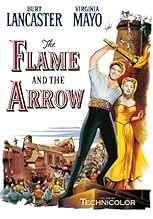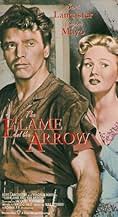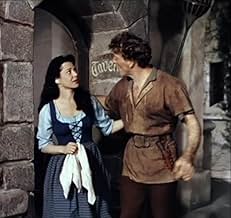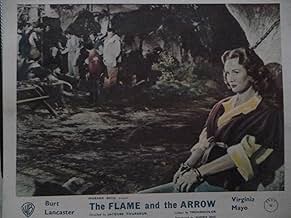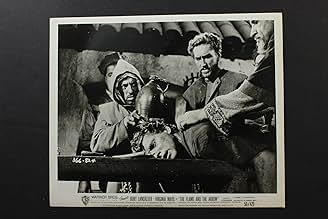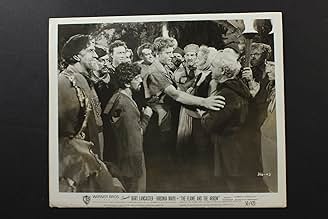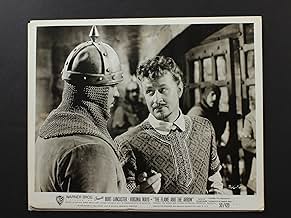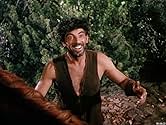IMDb RATING
6.8/10
4.5K
YOUR RATING
Dardo, a Robin Hood-like figure, and his loyal followers use a Roman ruin in Medieval Lombardy as their headquarters as they conduct an insurgency against their Hessian conquerors.Dardo, a Robin Hood-like figure, and his loyal followers use a Roman ruin in Medieval Lombardy as their headquarters as they conduct an insurgency against their Hessian conquerors.Dardo, a Robin Hood-like figure, and his loyal followers use a Roman ruin in Medieval Lombardy as their headquarters as they conduct an insurgency against their Hessian conquerors.
- Nominated for 2 Oscars
- 2 wins & 2 nominations total
Lynn Baggett
- Francesca
- (as Lynne Baggett)
Paul Baxley
- Guard
- (uncredited)
Leon Belasco
- Arturo of Milan
- (uncredited)
- …
Ray Beltram
- Townsman
- (uncredited)
Richard Brehm
- Outlaw
- (uncredited)
George Bruggeman
- Guard
- (uncredited)
- Director
- Writer
- All cast & crew
- Production, box office & more at IMDbPro
Featured reviews
"The Flame & The Arrow" (1950)was one of the last of the great Warner Bros. swashbucklers. From a screenplay by Waldo Salt this hugely enjoyable romp was directed with great flair by Jacques Tourneur. It was originally planned as a vehicle for Errol Flynn but by the time the picture went into production the erstwhile heroic Flynn was past his sell-by date and would be unable for the knockabout antics the part demanded (he had barely got through "The Adventures Of Don Juan" two years previously thanks to many short takes and having doubles perform a lot of his action scenes). Instead, a young and stunningly acrobatic Burt Lancaster was cast as Dardo, a sort of Robin Hood in medieval Italy fighting the oppression of the occupying Hessions.
Produced by Lancaster's Norma Productions (named after his wife) it was fully fleshed out with a splendid cast. Playing Dardo's mute friend Piccolo was Nick Cravat - Lancaster's friend and fellow performer from their circus days.The lovely Virginia Mayo played the love interest Anne of Hess. Robert Douglas is a likable rogue through most of the picture until he gets a taste of power and turns bad and Frank Allenby, looking remarkably like the Great Profile John Barrymore, played the villainous Hawk (the original title of the movie was "The Hawk & The Arrow").
Lancaster is marvellous to watch! Performing all his own stunts his high flying antics are a joy to behold. No other actor, before or since, would prove to be so agile and provide such a spirited performance! His athletic prowess is outstanding and little wonder he was Warner's first choice to play the great native American athlete Jim Thorpe in their biographical "Jim Thorpe-All American" (aka "Man Of Bronz") in 1952. Although he did a kind of follow-up to "The Flame & The Arrow" two years later with the more comical "The Crimson Pirate" it is a shame he then ceased doing this type of movie as we could have tolerated him in quite a few more of them.
Beautifully photographed in colour by the great Ernest Haller the movie has all the hallmarks of Warner's high production values. Adding greatly to the picture's proceedings is the wonderful Italianate score by Max Steiner! His ebullient music, like the picture, is a total delight especially his infectious and hum inducing main theme for Dardo scored for mandolins and orchestra and the gorgeous love theme for the scenes with Dardo & the lady Anne. There's a splendid driving battle theme too! Steiner's music was nominated for an Acadamy Award but lost out to Franz Waxman's darker "Sunset Boulevard".
The picture has transferred extremely well to disc with sharp images and fine colour resolution but quite dispensable are a Merrie Melodies cartoon and a tired Joe McDoakes short. It is also a pity that a documentary of Lancaster was not included.
Produced by Lancaster's Norma Productions (named after his wife) it was fully fleshed out with a splendid cast. Playing Dardo's mute friend Piccolo was Nick Cravat - Lancaster's friend and fellow performer from their circus days.The lovely Virginia Mayo played the love interest Anne of Hess. Robert Douglas is a likable rogue through most of the picture until he gets a taste of power and turns bad and Frank Allenby, looking remarkably like the Great Profile John Barrymore, played the villainous Hawk (the original title of the movie was "The Hawk & The Arrow").
Lancaster is marvellous to watch! Performing all his own stunts his high flying antics are a joy to behold. No other actor, before or since, would prove to be so agile and provide such a spirited performance! His athletic prowess is outstanding and little wonder he was Warner's first choice to play the great native American athlete Jim Thorpe in their biographical "Jim Thorpe-All American" (aka "Man Of Bronz") in 1952. Although he did a kind of follow-up to "The Flame & The Arrow" two years later with the more comical "The Crimson Pirate" it is a shame he then ceased doing this type of movie as we could have tolerated him in quite a few more of them.
Beautifully photographed in colour by the great Ernest Haller the movie has all the hallmarks of Warner's high production values. Adding greatly to the picture's proceedings is the wonderful Italianate score by Max Steiner! His ebullient music, like the picture, is a total delight especially his infectious and hum inducing main theme for Dardo scored for mandolins and orchestra and the gorgeous love theme for the scenes with Dardo & the lady Anne. There's a splendid driving battle theme too! Steiner's music was nominated for an Acadamy Award but lost out to Franz Waxman's darker "Sunset Boulevard".
The picture has transferred extremely well to disc with sharp images and fine colour resolution but quite dispensable are a Merrie Melodies cartoon and a tired Joe McDoakes short. It is also a pity that a documentary of Lancaster was not included.
Both this film and The Crimson Pirate established Burt Lancaster's reputation in the swashbuckling genre. When discussing Lancaster's career even with Oscar nominations and one Oscar for roles vastly different than who he plays in The Flame And The Arrow, I find it fascinating that so many still refer back to these films and label Lancaster a swashbuckling star like Errol Flynn.
Taking place in medieval Lombardy, the province is part of the Holy Roman Empire and they have a particularly evil Hessian provincial governor in Frank Allenby, known as "the Hawk" for his partiality to falconry and for his rapacious designs. Five years before, Allenby just took for himself the bored wife of Burt Lancaster played by Lynne Baggett leaving him to raise their son Gordon Gebert.
Now however Allenby at Baggett's suggestion comes in and takes Gebert away from a wounded Lancaster. Up to this time Lancaster has lived isolated in the mountains. Now he finally decides to join the rebels in revolt against Allenby and the Empire. Nothing like a little child stealing to provide motivation.
Before taking up acting Lancaster and his partner Nick Cravat were circus performers and his natural abilities in that direction made producers want to cast him in films like The Flame And The Arrow. But Lancaster knew his talent and always tried and succeeded in getting better parts. He never did want to have the career of Errol Flynn.
Burt also gets the opportunity to romance Allenby's niece Virginia Mayo who is being offered to a recently impoverished count Robert Douglas in the hopes of peace and unity. Douglas however is working an agenda all his own in The Flame And The Arrow. Mayo is curiously enough the mirror image of Baggett. She's bored with court life and finds certain attractions among the peasants especially the lusty and charismatic Lancaster.
And Burt has the charisma going full blast in this film. As well he would have to, otherwise why would the peasants be following him. It's an expansive part and no one could be as expansive as Burt Lancaster when the part called for it.
The Flame And The Arrow holds up well today. It should as it has a universal theme of a man protecting his child.
Taking place in medieval Lombardy, the province is part of the Holy Roman Empire and they have a particularly evil Hessian provincial governor in Frank Allenby, known as "the Hawk" for his partiality to falconry and for his rapacious designs. Five years before, Allenby just took for himself the bored wife of Burt Lancaster played by Lynne Baggett leaving him to raise their son Gordon Gebert.
Now however Allenby at Baggett's suggestion comes in and takes Gebert away from a wounded Lancaster. Up to this time Lancaster has lived isolated in the mountains. Now he finally decides to join the rebels in revolt against Allenby and the Empire. Nothing like a little child stealing to provide motivation.
Before taking up acting Lancaster and his partner Nick Cravat were circus performers and his natural abilities in that direction made producers want to cast him in films like The Flame And The Arrow. But Lancaster knew his talent and always tried and succeeded in getting better parts. He never did want to have the career of Errol Flynn.
Burt also gets the opportunity to romance Allenby's niece Virginia Mayo who is being offered to a recently impoverished count Robert Douglas in the hopes of peace and unity. Douglas however is working an agenda all his own in The Flame And The Arrow. Mayo is curiously enough the mirror image of Baggett. She's bored with court life and finds certain attractions among the peasants especially the lusty and charismatic Lancaster.
And Burt has the charisma going full blast in this film. As well he would have to, otherwise why would the peasants be following him. It's an expansive part and no one could be as expansive as Burt Lancaster when the part called for it.
The Flame And The Arrow holds up well today. It should as it has a universal theme of a man protecting his child.
One of the more enjoyable swinging-from-the-chandelier-with-a- -sword adventures made a la Erroll Flynn. A lively pace, loads of action, a witty-if-fluffy script, an enchanting score, good performances, and above all an incredible number of acrobatic stunts make this utterly enjoyable. Lancaster had been a circus acrobat before he got into films, and managed to work every stunt he could do into the script. He even balances and poses on the top of a 20-foot pole, for real. I'm still amazed that a guy that big could be so good.
(This film also had an ongoing effect on Hollywood: At the time Lancaster's career was fading, he was typecast as a big dumb lug in the kind of Film Noir that was rapidly going out of fashion. He realized that he had to do something, and rather than rely on the studios he bought this script and produced it himself. And gave himself a whole new career, an example not lost on other actors. This was one of the films that marked the beginning of the end of the paternalistic studio system, one that showed actors that they could control their own careers. For good or ill.)
(This film also had an ongoing effect on Hollywood: At the time Lancaster's career was fading, he was typecast as a big dumb lug in the kind of Film Noir that was rapidly going out of fashion. He realized that he had to do something, and rather than rely on the studios he bought this script and produced it himself. And gave himself a whole new career, an example not lost on other actors. This was one of the films that marked the beginning of the end of the paternalistic studio system, one that showed actors that they could control their own careers. For good or ill.)
Set in a little-remembered historical setting, the 1950 Warner Bros. swashbuckler "The Flame and the Arrow" finds its star, Burt Lancaster, showing off his great acrobatic prowess for the first time on screen. Since his spectacular debut in 1946's "The Killers," Lancaster had been featured in a run of moody, dramatic and noirish thrillers, but here, in his 10th picture (not counting his cameo appearance in 1947's "Variety Girl"), Burt finally seemed to be having some fun on the big screen. Appearing in color for the first time, big Burt here plays a character named Dardo Bartoli. A single father who lives in the Lombardy region in what we must presume to be the mid-12th century (the period when the Lombard League was formed to oust the Emperor Frederick Barbarossa and his Hessians, who had captured Milan in 1158 and burned it in 1162), Dardo has more than ample reason to be aggrieved with the Hessian Count Ulrich, aka The Hawk (hissably portrayed by Frank Allenby). Dardo's ex-wife had earlier "taken up" with the count, and his young son Rudi is soon kidnapped and ensconced in the count's well-guarded castle. Thus, accompanied by his friend Piccolo (Lancaster's boyhood pal Nick Cravat), the two attempt a rescue, but must ultimately content themselves with the kidnapping of the count's luscious niece, Anne of Hesse (beautiful-as-always Virginia Mayo), in the hopes of an exchange. But complications, both logistical and romantic, naturally ensue....
"The Flame and the Arrow" is a film that seems to be not as highly regarded as Lancaster and Cravat's follow-up swashbuckler, 1952's "The Crimson Pirate," which, in the interest of complete honesty--and to my own personal embarrassment--I must admit to not having seen. Still, the duo's initial outing has much to offer to the fun-loving fan of Saturday matinée-type entertainments. Lancaster and Cravat--who had formed the Lang and Cravat acrobatic team in the 1930s and performed extensively in circuses and nightclubs--get to show off their physical stunts here in various action situations, and although the two were hardly youngsters at this point (Burt was 37; Nick, 39), they are still remarkably impressive. No need for stuntmen with these two around, that's for sure! The film throws in a number of rousing combat scenes, and concludes with one of the great unsung swordfights in screen history, between Dardo and the traitorous Marchese Granazia (a nicely ambiguous performance from Robert Douglas); just look at how ferociously Burt swings his sword around in this scene! Virginia Mayo, a year after her terrific performance as James Cagney's moll Verna in "White Heat," looks absolutely sensational here in supersaturated Technicolor, and famed character actors Aline MacMahon and Victor Kilian are just fine in smaller roles. But this is most assuredly Burt's picture all the way, and his manifest joy in playing a physical-action character in a period swashbuckler is quite contagious. With that flashing grin and million-dollar set of teeth, no wonder all the girls in Lombardy seem to have a major thang for him! And thus, how little sympathy the viewer has for Dardo's wife, Francesca (Lynn Baggett), who would give up this man, as well as her cute son (appealingly played by young Gordon Gebert), in order to live with the evil but wealthy count!
"The Flame and the Arrow" was directed by the great Jacques Tourneur, the French-born filmmaker who is perhaps best remembered today for his 1940s RKO horror films--"The Cat People," "I Walked With a Zombie" and "The Leopard Man" (all made for producer Val Lewton)--as well as for the cult item "Curse of the Demon"; here, Tourneur demonstrates that he could be just as skilled and effective in another, nonhorror genre. Finally, I would be remiss if I failed to mention the lovely score that has been provided here by the renowned Max Steiner, who had previously contributed to such "minor" films as "King Kong," "Top Hat," "Gone With the Wind," "Sergeant York," "Now, Voyager," "Casablanca," "Mildred Pierce," "The Treasure of the Sierra Madre" and, again, "White Heat," in addition to a few hundred others (what an amazing career!). A classy affair from start to finish, "The Flame and the Arrow" is very much your standard Hollywood adventure fare, but done to a turn by a cast and crew that obviously took great pride in their craft; truly, a rousing entertainment for audience members of all ages.
"The Flame and the Arrow" is a film that seems to be not as highly regarded as Lancaster and Cravat's follow-up swashbuckler, 1952's "The Crimson Pirate," which, in the interest of complete honesty--and to my own personal embarrassment--I must admit to not having seen. Still, the duo's initial outing has much to offer to the fun-loving fan of Saturday matinée-type entertainments. Lancaster and Cravat--who had formed the Lang and Cravat acrobatic team in the 1930s and performed extensively in circuses and nightclubs--get to show off their physical stunts here in various action situations, and although the two were hardly youngsters at this point (Burt was 37; Nick, 39), they are still remarkably impressive. No need for stuntmen with these two around, that's for sure! The film throws in a number of rousing combat scenes, and concludes with one of the great unsung swordfights in screen history, between Dardo and the traitorous Marchese Granazia (a nicely ambiguous performance from Robert Douglas); just look at how ferociously Burt swings his sword around in this scene! Virginia Mayo, a year after her terrific performance as James Cagney's moll Verna in "White Heat," looks absolutely sensational here in supersaturated Technicolor, and famed character actors Aline MacMahon and Victor Kilian are just fine in smaller roles. But this is most assuredly Burt's picture all the way, and his manifest joy in playing a physical-action character in a period swashbuckler is quite contagious. With that flashing grin and million-dollar set of teeth, no wonder all the girls in Lombardy seem to have a major thang for him! And thus, how little sympathy the viewer has for Dardo's wife, Francesca (Lynn Baggett), who would give up this man, as well as her cute son (appealingly played by young Gordon Gebert), in order to live with the evil but wealthy count!
"The Flame and the Arrow" was directed by the great Jacques Tourneur, the French-born filmmaker who is perhaps best remembered today for his 1940s RKO horror films--"The Cat People," "I Walked With a Zombie" and "The Leopard Man" (all made for producer Val Lewton)--as well as for the cult item "Curse of the Demon"; here, Tourneur demonstrates that he could be just as skilled and effective in another, nonhorror genre. Finally, I would be remiss if I failed to mention the lovely score that has been provided here by the renowned Max Steiner, who had previously contributed to such "minor" films as "King Kong," "Top Hat," "Gone With the Wind," "Sergeant York," "Now, Voyager," "Casablanca," "Mildred Pierce," "The Treasure of the Sierra Madre" and, again, "White Heat," in addition to a few hundred others (what an amazing career!). A classy affair from start to finish, "The Flame and the Arrow" is very much your standard Hollywood adventure fare, but done to a turn by a cast and crew that obviously took great pride in their craft; truly, a rousing entertainment for audience members of all ages.
Lively, colorful period romp in the Warners’ style made in the wake of ADVENTURES OF DON JUAN (1948) – featuring the same villain, Robert Douglas, no less – but actually fashioned after their most successful swashbuckler, THE ADVENTURES OF ROBIN HOOD (1938).
Burt Lancaster – with his acrobatic training and cheerful countenance in full bloom – is perfect casting for the heroic role of Dardo, a kind of Italian Robin Hood (even down to displaying similar prowess as an archer); Virginia Mayo, then, makes for an ideal heroine – like Olivia De Havilland’s Maid Marian, playing a noble woman who’s gradually drawn to the outlaw’s cause. Again, like the 1938 Robin Hood film, we have two villains: Frank Allenby as a tyrant known as “The Hawk” and the afore-mentioned Douglas as a Marquis; the latter’s role is interesting in that, banished by the former for tax evasion, he manages to infiltrate Lancaster’s band (along with his smart companion, a troubadour played by Norman Lloyd) and outwardly reform – but, when the opportunity arises, proceeds to reveal their plan of attack to Allenby!
Other twists and quirks to the Robin Hood formula (the sharp script was written by Waldo Salt, later an Oscar winner for MIDNIGHT COWBOY [1969]!) are the fact that Lancaster’s wife has left him for Allenby - their spirited son has remained with Lancaster, whom he idolizes, but is eventually captured and thought good manners against his will; when Lancaster imprisons Mayo in exchange for his son’s freedom, he keeps her chained by the neck to a tree!; for no apparent reason other than that he's able to, one of Lancaster’s men uses his feet to write ransom notes, etc.; Lancaster is sent to the gallows but, here, he gives himself up rather than being captured and actually fakes his own death!; and the climactic struggle inside the castle, which the gang penetrate incognito (this time dressed-up as a band of strolling players). The obligatory swordfight between Lancaster and Douglas, then, is given a novel touch by being partly set in the dark – the only evident nod to the noir style director Tourneur is best-known for!
The film itself received a couple of Oscar nominations for Ernest Haller’s gorgeous cinematography and Max Steiner’s marvelous score (it too bears a striking resemblance to Erich Wolfgang Korngold’s unforgettable work on THE ADVENTURES OF ROBIN HOOD – as do the castle interiors – but this takes nothing away from the quality of THE FLAME AND THE ARROW itself!). Also worth noting in the cast is Nick Cravat as Lancaster’s mute sidekick: in the star’s days as an acrobat, he had been his partner and would often work with him in films – basically reprising his role here in Lancaster’s next swashbuckler, the seafaring THE CRIMSON PIRATE (1952; incidentally, also surprisingly but vigorously helmed by an expert in film noir, Robert Siodmak). Speaking of the latter, a couple of years back I re-acquainted myself with it via a rental of Warner’s bare-bones DVD edition – but its predecessor/companion piece is, mysteriously, still M.I.A. on disc...
Burt Lancaster – with his acrobatic training and cheerful countenance in full bloom – is perfect casting for the heroic role of Dardo, a kind of Italian Robin Hood (even down to displaying similar prowess as an archer); Virginia Mayo, then, makes for an ideal heroine – like Olivia De Havilland’s Maid Marian, playing a noble woman who’s gradually drawn to the outlaw’s cause. Again, like the 1938 Robin Hood film, we have two villains: Frank Allenby as a tyrant known as “The Hawk” and the afore-mentioned Douglas as a Marquis; the latter’s role is interesting in that, banished by the former for tax evasion, he manages to infiltrate Lancaster’s band (along with his smart companion, a troubadour played by Norman Lloyd) and outwardly reform – but, when the opportunity arises, proceeds to reveal their plan of attack to Allenby!
Other twists and quirks to the Robin Hood formula (the sharp script was written by Waldo Salt, later an Oscar winner for MIDNIGHT COWBOY [1969]!) are the fact that Lancaster’s wife has left him for Allenby - their spirited son has remained with Lancaster, whom he idolizes, but is eventually captured and thought good manners against his will; when Lancaster imprisons Mayo in exchange for his son’s freedom, he keeps her chained by the neck to a tree!; for no apparent reason other than that he's able to, one of Lancaster’s men uses his feet to write ransom notes, etc.; Lancaster is sent to the gallows but, here, he gives himself up rather than being captured and actually fakes his own death!; and the climactic struggle inside the castle, which the gang penetrate incognito (this time dressed-up as a band of strolling players). The obligatory swordfight between Lancaster and Douglas, then, is given a novel touch by being partly set in the dark – the only evident nod to the noir style director Tourneur is best-known for!
The film itself received a couple of Oscar nominations for Ernest Haller’s gorgeous cinematography and Max Steiner’s marvelous score (it too bears a striking resemblance to Erich Wolfgang Korngold’s unforgettable work on THE ADVENTURES OF ROBIN HOOD – as do the castle interiors – but this takes nothing away from the quality of THE FLAME AND THE ARROW itself!). Also worth noting in the cast is Nick Cravat as Lancaster’s mute sidekick: in the star’s days as an acrobat, he had been his partner and would often work with him in films – basically reprising his role here in Lancaster’s next swashbuckler, the seafaring THE CRIMSON PIRATE (1952; incidentally, also surprisingly but vigorously helmed by an expert in film noir, Robert Siodmak). Speaking of the latter, a couple of years back I re-acquainted myself with it via a rental of Warner’s bare-bones DVD edition – but its predecessor/companion piece is, mysteriously, still M.I.A. on disc...
Did you know
- TriviaNick Cravat, who plays Piccolo, was an acrobat who was teamed with Burt Lancaster before Lancaster became a star. He appears in many of Lancaster's movies. In this one, and in Le corsaire rouge (1952), he plays a mute. The reason was that his thick Brooklyn accent, which he could not lose, would have been wildly out of place in such period pieces.
- GoofsWhen Piccolo is fighting the guardsman in the balcony he flips his sword around and holds the blade with his hand (showing it cannot be sharp) and then whacks the guardsman with the broad side of the blade near the hilt, bending it at least 20-25 degrees.
- ConnectionsReferenced in The John Player Lecture with Burt Lancaster (1972)
- How long is The Flame and the Arrow?Powered by Alexa
Details
- Release date
- Country of origin
- Language
- Also known as
- El halcón y la flecha
- Filming locations
- Production companies
- See more company credits at IMDbPro
Box office
- Budget
- $1,600,000 (estimated)
- Gross worldwide
- $6,713
- Runtime
- 1h 28m(88 min)
- Aspect ratio
- 1.37 : 1
Contribute to this page
Suggest an edit or add missing content


